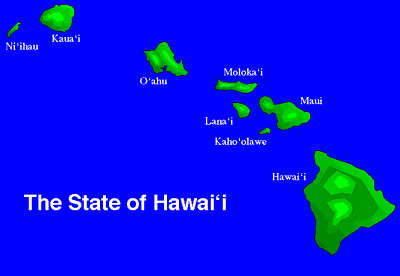 (More to come)
(More to come)Hawai`i officially became the 50th state in the American Union on August 21, 1959.

This pages and the images which accompany it were provided by the University of Hawaii.
 (More to come)
(More to come)
Hawai`i officially became the 50th state in the American Union on August 21, 1959.
Measuring from its submarine base (3,280 fathoms) in the Hawaiian Trough to the top of the mountain (13,796 feet), Mauna Kea is the tallest mountain in the world with a combined height of 33,476 feet.
The July 1, 1991 resident population for the State of Hawai`i was 1,134,800 persons. (Between the 1980 and 1990 Census counts -- 964,691 and 1,108,229 persons -- Hawai`i's population grew 14.9 percent).
Geographic coordinates of Honolulu, the state capital, is 21 18 25 North Latitude, 157 51 30 West Longitude.
The State Seal has a heraldic shield in the center and a figure of King Kamehameha I on its right side and the Goddess of Liberty holding the Hawaiian flag on its left. Below the shield is the Phoenix surrounded by taro leaves, banana foliage, and sprays of maidenhair fern. Statehood was achieved in 1959. With color added, the seal becomes the State Coat of Arms.
The State Flower is the yellow Hibiscus Brackenridgei. The official flowers and colors for each island is as follows:Hawai`i's State Tree is the kukui, better known as the candlenut. The nuts of this tree provided the ancient Hawaiians with light, oil, relishes, and medicine.
The State Bird: The Nene (pronounced "nay-nay") is a land bird and a variety of goose. It has adapted itself to life in the harsh lava country by transforming its webbed feet into a claw-like shape and modifying its wing structure for shorter flights. Hunting and wild animals all but destroyed the species until they were protected by law and a restoration project established in 1949.
Marine Mammal: The Humpback Whale, an annual visitor to Hawaiian waters and so designated in 1979.
State Fish: The Humuhumunukunukuapua`a (pronounced "humuhumunukunukuapua`a").
Flag: The State Flag has eight stripes (representing the eight major islands), of white, red and blue; the field closely resembles the Union Jack of Great Britain, from which the original flag apparently was designed.
Motto: The words Ua mau ke ea o ka aina i ka pono which mean "The life of the land is perpetuated in righteousness." The saying is attributed to King Kamehameha III as of July 31, 1843, when the Hawaiian flag once more was raised after a brief period of unauthorized ursurpation of authority by a British admiral.
Anthem: Hawai`i Pono`i, written by King Kalakaua and set to music by Henry Berger, the Royal Bandmaster. It was also the anthem of the Kingdom and the Territory of Hawai`i.
